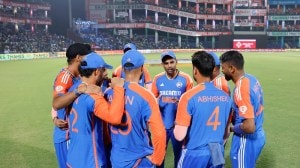‘Ganjing’ in Lucknow
India’s restructured economy is reshaping urban scapes — even in smaller towns

I returned to India after two and a half years. It was a two-week restricted stay in Lucknow for a wedding, an event traditionally marked by conspicuous consumption. Sure enough, a week before the wedding, we were out on the streets, consuming with a vengeance.
We descended on Lucknow’s famed shopping haunts, Hazratganj, Aminabad and Chowk. These were the places people went to shop, take in the social scene, eat kulfi or simply hang out. While Aminabad and Chowk are traditional markets, Hazratganj has the dignified air of a colonial promenade. Its colonnaded footpaths flank a wide road no longer than perhaps a kilometre. Anchored at one end by the now closed India Coffee House, it is a strip of fashionable shops with anglicised names. Amongst others, the precinct was the site of an art deco theatre called ‘Mayfair’, which predominantly showed Hollywood films and also housed the British Library. It was where the Raj’s memsahibs strolled leisurely on warm summer evenings. The colonnades of Hazratganj were for Lucknow what Benjamin’s Arcades meant for Paris.
Post-Independence Hazratganj continued to be the privileged shopping street. In the ’70s it expanded to include Janpath, a nondescript but beloved shopping ensemble. The act of leisurely strolling in Hazratganj had a colloquial epithet: ‘ganjing’. The student population could not get enough of it. On this visit, Ganj seemed to have lost some of its buzz. Its cherished architectural patina now looked positively neglected and decaying.
The stark reality of changing times came to bear as we breezed past a spanking new shopping mall, curiously called Sahara Ganj. Lucknow’s capital and desire had moved but a few metres away. Clearly ‘ganjing’ had taken on a new meaning. India’s restructured economy and growing consumerism is reshaping her urban scapes. Modes of production mould space according to Lefevbre; however, consumption and production are but flip sides of the same coin. Malls like Sahara Ganj are fragments of universal space that dot the planet in conjunction with airports and multiplexes. Mediated global flows of desire find scattered pools of capital with which they merge, establishing networks to further enhance flows of capital and desire.
Far from surrendering to the pressures of adopting or being overwhelmed by universal space, Sahara Ganj has taken on a local flavour. Unusual hybrids are created, for with the globally renowned fixture-in-the-mall McDonalds, Lucknow’s famous hole-in-the-wall tunda kababs rub shoulders in the air-conditioned food-court. The local presents itself through hybridisation — remnants and mutations, for example, of a treasured street life find new expression and compete with the global on its turf.
Photos





- 01
- 02
- 03
- 04
- 05

























